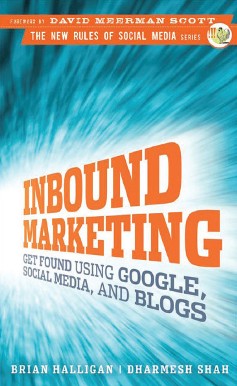By Ruth M. Shipley
 When little-known, first-term Illinois senator Barack Obama faced Hillary Clinton in the 2008 Democratic presidential campaign, he knew he couldn’t compete with her financially. He couldn’t afford telemarketing and direct mail campaigns or TV and radio advertising.
When little-known, first-term Illinois senator Barack Obama faced Hillary Clinton in the 2008 Democratic presidential campaign, he knew he couldn’t compete with her financially. He couldn’t afford telemarketing and direct mail campaigns or TV and radio advertising.So instead of playing by the old rules, he made new rules. He started blogging and he created profiles on Facebook, Twitter, LinkedIn and YouTube.
He also hired the co-founder of Facebook, Chris Hughes, to be his Internet strategist. And he won the Democratic presidential nomination even though he spent a lot less money than his opponent.
At the time of the election, Obama had five million fans on Facebook—over four million more than Clinton. On MySpace, the numbers were approximately 800,000 and 200,000, respectively. On Twitter, he had over 100,000 followers and his opponent had about 5,000.
And he did all of that by following the principles of inbound marketing.
If you still market your business the old-fashioned way, you’re using outbound marketing techniques. Outbound marketing is throwing your message into the public arena and hoping the “right people” see it. Inbound marketing is creating a message that only the right people would be interested in, and then helping them stumble upon it.
If you have trouble seeing the difference, consider this:
Outbound marketing—You spend hundreds of thousands of dollars to advertise the 2012 Lexus LFA during the Super Bowl. Only a tiny fraction of that audience would qualify financially.
Inbound marketing—You help people who have the income and the desire for the 2012 Lexus LFA to find your website, your blog and your YouTube channel.
Consumers Revolt Against In-Your-Face Marketing
I think I’m not the only one who’s fed up with traditional marketing techniques.
Many people have turned their collective backs on traditional advertising and ask their friends and family members for advice instead. They know any ad they see is just a sales pitch. And they probably don’t need whatever is being advertised.
But when they do need a product or service, they know their friends and families cangive them unbiased testimonials about the products and services they like. And tapping into those conversations is one of the new rules of marketing.
 So if spam-blockers, TiVo and mute buttons have convinced you to reconsider expensive outbound marketing techniques, have I got a book for you! It’s Inbound Marketing: Get Found Using Google, Social Media, and Blogsby Brian Halligan and Dharmesh Shah.
So if spam-blockers, TiVo and mute buttons have convinced you to reconsider expensive outbound marketing techniques, have I got a book for you! It’s Inbound Marketing: Get Found Using Google, Social Media, and Blogsby Brian Halligan and Dharmesh Shah.Getting found doesn’t mean spending hundreds of thousands of dollars to create a prime-time commercial that most viewers will mute. Or putting an online banner ad for an arthritis drug in front of a 21-year-old woman.
Getting found means writing extensively about your solution to someone else’s problem. And then helping people with that problem find your online documents. “In order to move from outbound to inbound marketing,” write Halligan and Shah, “you need to stop interrupting people in your target market and ‘get found’ by them instead.”
So these two MIT MBA grads wrote a brief manual to teach you the fundamentals of inbound marketing. “We have seen inbound marketing work first hand for hundreds of companies in a myriad of different industries. We’re confident it will work for you if you persevere and continually learn.”
Market the Way People Search for Information
“To be successful and grow your business and revenues, you must match the way you market your products with the way your prospects learn about and shop for your products,” write Halligan and Shah. “The era of interruption-based marketing is coming to an end because people have become much more efficient at blocking out these traditional methods of marketing and have become equally as efficient at finding trusted information online.”
Yes, you may have to forget everything you know about marketing. But Halligan and Shah will take you by the hand and teach you a brand-new set of marketing techniques. Their book has a companion website that includes the following resources:
- A forum where you can ask and answer questions about inbound marketing
- A directory of marketing service firms that can help you implement inbound marketing
- A collection of marketing news to keep you current
- A database of inbound marketing jobs for job-hunters and employers
Many of you may already know how to optimize your website, use an RSS reader and set up a YouTube channel. This book will teach you all of that and much more. You’ll also learn how to:
- Hire employees who understand inbound marketing principles
- Hire service providers using inbound marketing principles
- Use bivariate and multivariate testing to see which landing page draws more leads
- Grade leads so you spend more time on the ones who will become customers
- Create a lead-nurturing program so you don’t lose promising leads
- Analyze your competition using inbound marketing principles
If this sounds like a lot of work, it is! Did you think inbound marketing would be easy? Did you think all you had to do was set up a Google Alert to monitor mentions of your company name?
This book contains many tips for startups too. If you’re starting a business, you have one major advantage over established businesses when it comes to inbound marketing—you won’t have to “unlearn” anything!
“You no longer need to spend tons of money interrupting your potential customers. Instead you need to create remarkable content, optimize that content, publish the content, market the content, and measure what is working and what is not working,” write Halligan and Shah. “A savvy inbound marketer is half traditional marketer and half content creation factory.”
In fact, you can think of inbound marketing as the “Five C’s”: you’re Converting Creativity, Content, and Conversation into valuable Customers.
If you’re still clinging to traditional outbound marketing techniques, consider this final quote from Halligan and Shah: “On average, inbound marketing leads are 61 percent less expensive than outbound marketing leads.”
I thought that might get your attention.
So take a tip from Barack Obama. Pick up a copy of Inbound Marketing, cut your marketing bill in half and start a conversation with your customers. They’re waiting to hear from you.
For your marketing solutions, please check out our website at www.olamoana.com
See this Amp at http://amplify.com/u/apoz0


No comments:
Post a Comment